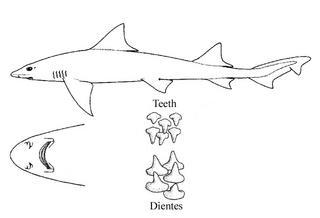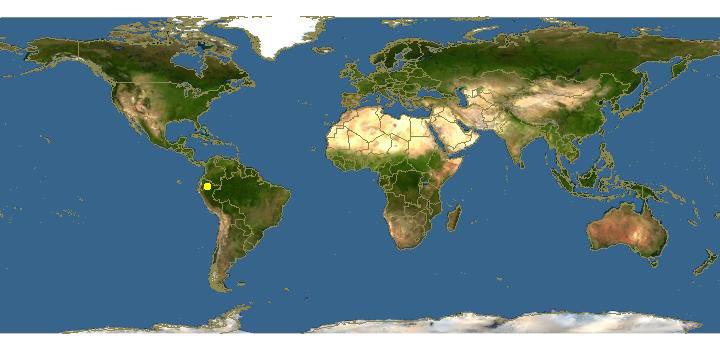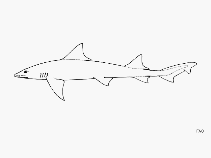
www.fao.org Copyright Michel Lamboeuf · 0
Triakis acutipinna |

Click on map for details about points.
|
| Links |
We parsed the following live from the Web into this page. Such content is managed by its original site and not cached on Discover Life. Please send feedback and corrections directly to the source. See original regarding copyrights and terms of use.
- FishBase
|
|
espa˝ol |
|
|
Overview |
Main identification features
- robust; snout short, rounded
- 1st dorsal fin midway pectoral/pelvic
- mouth convex
- pectorals curved
- lower lobe c: curved extension
Elongate, relatively robust body; snout short, bluntly rounded; mouth convex; eyes horizontal ovals, with ventral nictitating membranes; teeth with a single large central point; 5 gill slits, last 2 over pectoral fin base; pectorals curved with pointed tips in adults; 2 large dorsal fins, second slightly smaller than first; first dorsal fin with straight rear edge, centered midway between pectoral and pelvic bases; anal fin smaller than and with origin under middle of second dorsal; tail strongly asymmetrical, lower lobe with small point.
Grey.
Size: 127 cm.
Habitat: continental platform.
Depth: 50-200 m.
Southern Colombia to Peru.
Attributes
Abundance: Common.
Cites: Not listed.
Climate Zone: Equatorial (Costa Rica to Ecuador + Galapagos, Clipperton, Cocos, Malpelo); South Temperate (Peruvian Province ).
Depth Range Max: 200 m.
Depth Range Min: 50 m.
Diet: bony fishes; mobile benthic crustacea (shrimps/crabs).
Eastern Pacific Range: Northern limit=5; Southern limit=-5; Western limit=-82; Eastern limit=-78; Latitudinal range=10; Longitudinal range=4.
Egg Type: Live birth; No pelagic larva.
Feeding Group: Carnivore.
FishBase Habitat: Demersal.
Global Endemism: Tropical Eastern Pacific (TEP) endemic; East Pacific endemic; All species.
Habitat: Mud; Rocks; Soft bottom (mud, sand,gravel, beach, estuary & mangrove); Sand & gravel; Reef (rock &/or coral); Reef and soft bottom.
Inshore Offshore: Inshore; Inshore Only.
IUCN Red List: Vulnerable; Listed.
Length Max: 127 cm.
Regional Endemism: Continent only; Continent; TEP endemic; Continental TEP endemic; Panamic province endemic; All species.
Residency: Resident.
Salinity: Marine; Marine Only.
Water Column Position: Bottom; Bottom only;
|
|
|
Names | |
|
|
|
Links to other sites | |
|
|
|
References |
- BÚarez, P., 1996., Lista de los Peces Marinos del Ecuador Continental., Revista de Biologia Tropical, 44:731-741.
- Compagno, L.J.V., 1999., Checklist of living elasmobranchs. In Hamlett W.C. (ed.) Sharks, skates, and rays: the biology of elasmobranch fishes., The John Hopkins University Press:471-498.
- Compagno, L.J.V., 1984., Sharks of the World. An annotated and illustrated catalogue of shark species known to date. Part 2. Carcharhiniformes. FAO Species Catalogue., FAO Fish. Synop. No 125, 4(2):251-655.
- Fischer , W. , Krup , F. , Schneider , W. , Sommer , C. , Carpenter , K. E. and Niem, V. H., 1995., Guia FAO para la Identificacion de Especies de para los fines de la Pesca. Pacifico Centro-Oriental. Volumen II. Vertebrados - Parte 1., FAO2:647-1200.
- Jimenez-Prado, P., BÚarez, P., 2004., Peces marinos del Ecuador continental / Marine fishes of continental Ecuador., SIMBIOE/NAZCA/IFEA tomo 1 y 2.
- Kato,., 1968., Triakis acutipinna (Galeoidea, Triakidae), a new species of shark from Ecuador., Copeia, 1968:319-325.
- Rubio, E.A., 1988., Estudio taxonomico de la ictiofauna acompa˝ante del camaron en areas costeras del Pacifico de Colombia., Memorias del VI Seminario Nacional de las Ciencias del Mar. Comisiˇn Colombiana de OceanografÝa. Bogota, Colombia., :169-183.
|
|
|
Acknowledgements | |
I thank Ashley MacDonald and John Pickering, University of Georgia, for technical support in building this page.
|
|
| Supported by | |
|
Following modified from FishBase
|
Top | See original
http://www.fishbase.org/Summary/speciesSummary.php?genusname=Triakis&speciesname=acutipinna ---> http://192.134.151.83/Summary/speciesSummary.php?genusname=Triakis&speciesname=acutipinna
http://192.134.151.83/Summary/speciesSummary.php?genusname=Triakis&speciesname=acutipinna ---> https://fishbase.mnhn.fr/Summary/speciesSummary.php?genusname=Triakis&speciesname=acutipinna
https://fishbase.mnhn.fr/Summary/speciesSummary.php?genusname=Triakis&speciesname=acutipinna ---> https://fishbase.mnhn.fr/summary/Triakis-acutipinna.html
Triakis acutipinna, Sharpfin houndshark

You can
sponsor
this page
Common name (e.g. trout)
Genus + Species (e.g. Gadus morhua)
-

-
About this page
-
Languages
-
User feedbacks
-
Citation
-
Uploads
-
Related species
-


 Sharpfin houndshark
Upload your
photos
and
videos
Sharpfin houndshark
Upload your
photos
and
videos
Pictures
|
Google image
 Triakis acutipinna
Triakis acutipinna
Picture by
FAO
Elasmobranchii (sharks and rays) >
Carcharhiniformes
(Ground sharks) >
Triakidae
(Houndsharks) > Triakinae
Etymology:
Triakis:
tri-
, from
tres
(L.), three;
akis
(Gr.), point, referring to each tooth consisting of one large central cusp flanked on by both sides by a small cusplet. (
See ETYFish
)
;
acutipinna:
acutus
(L.), sharp or pointed;
pinna
(L.), fin, referring to its sharp-tipped fins. (
See ETYFish
)
.
Environment: milieu / climate zone / depth range / distribution range
Ecology
Marine; demersal. Tropical; 0°S - 4°S
Eastern Pacific: known only from Ecuador.
Size / Weight / Age
Maturity: L
m
?
range ? - ? cm
Max length : 90.0 cm TL male/unsexed; (Ref.
244
); 102.0 cm TL (female)
Known only from two specimens. Ovoviviparous (Ref.
50449
).
Life cycle and mating behavior
Maturity
|
Reproduction
|
Spawning
|
Eggs
|
Fecundity
|
Larvae
Ovoviviparous, embryos feed solely on yolk (Ref.
50449
).
Compagno, L.J.V.
, 1984. FAO Species Catalogue. Vol. 4. Sharks of the world. An annotated and illustrated catalogue of shark species known to date. Part 2 - Carcharhiniformes. FAO Fish. Synop. 125(4/2):251-655. Rome: FAO. (Ref.
244
)
IUCN Red List Status (Ref.
130435
)
Endangered (EN)
(B1ab(v); C2a(ii)); Date assessed:
23 September 2020
CITES
Not Evaluated
Not Evaluated
Threat to humans
Harmless
Human uses
Fisheries: of no interest
FAO - Publication:
search
|
FishSource
|
More information
Countries
FAO areas
Ecosystems
Occurrences
Introductions
Stocks
Ecology
Diet
Food items
Food consumption
Ration
Common names
Synonyms
Metabolism
Predators
Ecotoxicology
Reproduction
Maturity
Spawning
Spawning aggregation
Fecundity
Eggs
Egg development
Age/Size
Growth
Length-weight
Length-length
Length-frequencies
Morphometrics
Morphology
Larvae
Larval dynamics
Recruitment
Abundance
BRUVS
References
Aquaculture
Aquaculture profile
Strains
Genetics
Electrophoreses
Heritability
Diseases
Processing
Nutrients
Mass conversion
Collaborators
Pictures
Stamps, Coins Misc.
Sounds
Ciguatera
Speed
Swim. type
Gill area
Otoliths
Brains
Vision
Tools
E-book
|
Field guide
|
Length-frequency wizard
|
Life-history tool
|
Point map
|
Classification Tree
|
Catch-MSY
|
Special reports
Check for Aquarium maintenance
|
Check for Species Fact Sheets
|
Check for Aquaculture Fact Sheets
Download XML
Summary page
|
Point data
|
Common names
|
Photos
Internet sources
AFORO (otoliths) |
Aquatic Commons
|
BHL
|
Cloffa
|
BOLDSystems
|
Websites from users
|
Check FishWatcher
|
CISTI
|
Catalog of Fishes
:
genus
,
species
|
DiscoverLife
|
ECOTOX
| FAO - Publication:
search
|
Faunafri
| Fishipedia |
Fishtrace
| GenBank:
genome
,
nucleotide
| GloBI |
Google Books
|
Google Scholar
|
Google
| IGFA World Record |
MitoFish
|
Otolith Atlas of Taiwan Fishes
|
PubMed
| Reef Life Survey | Socotra Atlas |
Tree of Life
| Wikipedia:
Go
,
Search
| World Records Freshwater Fishing |
Zoobank
|
Zoological Record
Estimates based on models
Phylogenetic diversity index (Ref.
82804
): PD
50
= 0.5312 [Uniqueness, from 0.5 = low to 2.0 = high].
Bayesian length-weight: a=0.00240 (0.00110 - 0.00521), b=3.14 (2.96 - 3.32), in cm total length, based on LWR estimates for this (Sub)family-body shape (Ref.
93245
).
Trophic level (Ref.
69278
): 3.7 ±0.2 se; based on size and trophs of closest relatives
Resilience (Ref.
120179
): Low, minimum population doubling time 4.5 - 14 years (Fec assumed to be <100).
Fishing Vulnerability (Ref.
59153
): High vulnerability (61 of 100).
Back to Search
Random Species
Back to Top
Accessed through:
Not available
FishBase mirror site :
localhost
Page last modified by :
mrius-barile
- 20 July 2016
Fatal error
: Uncaught ArgumentCountError: Too few arguments to function checkEcotox(), 1 passed in /var/www/html/summary/speciessummary.php on line 2304 and exactly 3 expected in /var/www/html/includes/speciessummary.lib.php:2579 Stack trace: #0 /var/www/html/summary/speciessummary.php(2304): checkEcotox() #1 {main} thrown in
/var/www/html/includes/speciessummary.lib.php
on line
2579
|
Updated: 2024-06-19 22:56:17 gmt
|